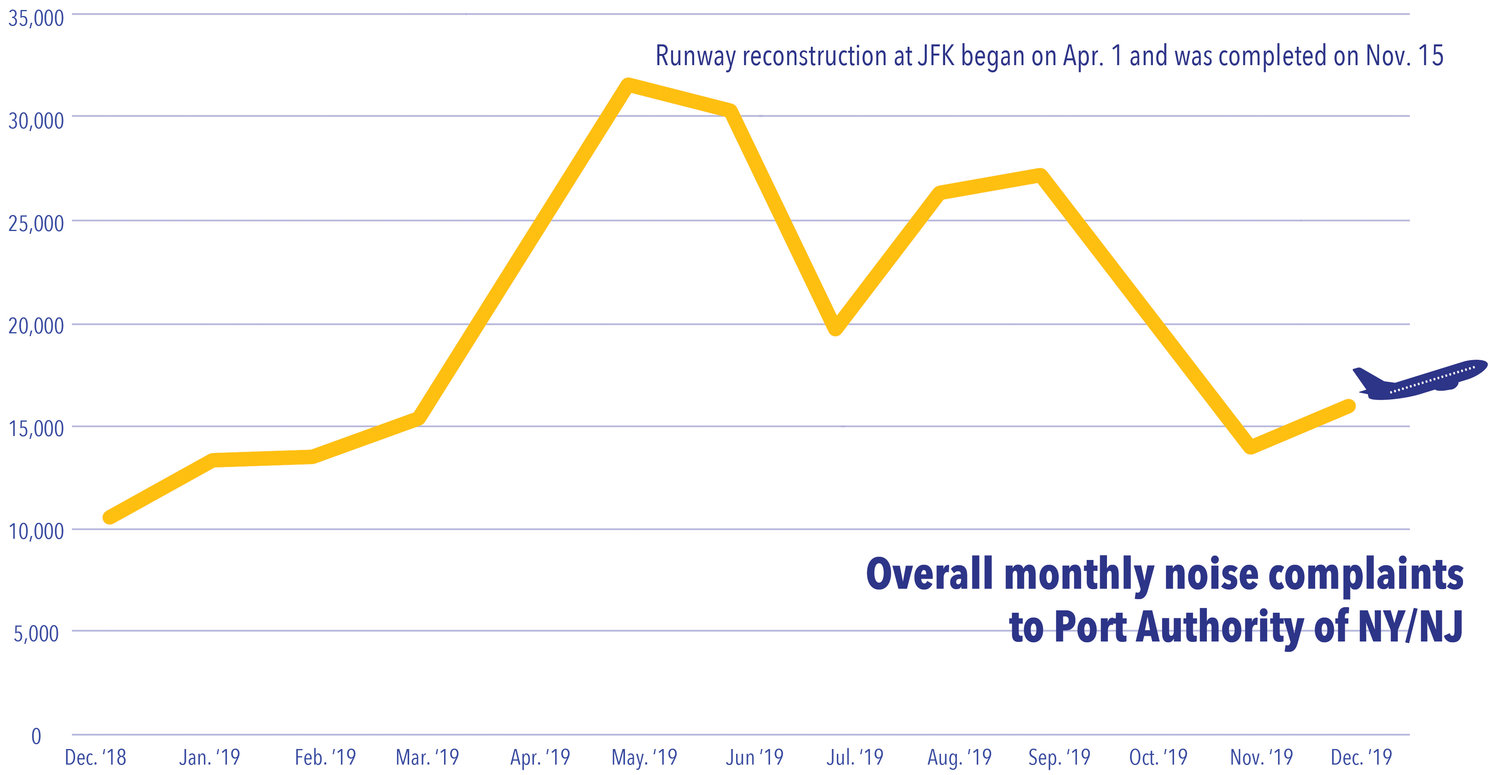Plane noise complaints drop after JFK runway reconstruction ends
From April 1 to shortly after Nov. 15, Valley Streamers were subjected to sustained levels of increased plane noise as two of John F. Kennedy International Airport’s main runways were closed for reconstruction.
During that period, noise complaints to the Port Authority of New York and New Jersey, which operates the airport, skyrocketed, with the monthly volume jumping from around 15,000 in March to more than 23,000 the following month, then peaking in May at nearly 31,600, according to the authority’s reports.
Last spring, the Herald spoke with Valley Stream resident Ulla Kjarval, who, while nursing a newborn at home, said her situation had made her acutely aware of additional noise.
Her daughter is now almost 10 months old, and Kjarval said she was happy to report that except for evenings of bad weather and some other random periods, the plane noise levels have improved in the weeks since the runways reopened.
“Yes, there has been a reprieve from the constant plane noise,” Kjarval said. “. . . A few weeks ago it was unbearable . . . however, it has generally been better since the runway completion.”
Other Valley Streamers ex-pressed mixed sentiments. Responding to a Herald social media request for comments, resident Danielle Phanord wrote that the noise was “still ridiculous.”
“Better so far but I’m more interested in how it will be [in the] spring and summer,” Mary Lou Gillen commented.
The summer months see an increase in flights to and from JFK, according to the Port Authority, from an average of 37,000 arrivals and departures per month to around 40,000.
Others residents said that because they live less than five miles from JFK, plane noise will always be an issue. “It’s Valley Stream people,” Caroline Tortorici Vila wrote. “We live very close to the airport.”
The $355 million reconstruction project at JFK involved the widening and lengthening of parallel runways 31R/13L and 13R/31L, upgrades to lighting and electrical systems and the use of concrete to increase their operational lifespan to 40 years, rather than eight to 12.
The closing of the two runways resulted in major changes to the flight patterns for planes landing and taking off at the airport.
Most of the arrivals and departures for 31R/13L — which has historically handled a third of the airport’s traffic — and 13R/31L were transferred to the airport’s remaining two runways, with some seeing an increase of traffic by as much as 10,000 flights in a month.
For Valley Stream, arrivals at the northeast end of 22L/4R, whose flight path lies above the neighborhood, saw an increase from nearly 3,000 in February to more than 9,400 in April, after construction began.
Additionally, departures, which tend to be louder as pilots increase jet engine throttle for takeoff, from the northeast end of runway 22R/4L, whose flight path is above Elmont, also saw a similar increase, going from roughly 2,500 takeoffs in February to more than 9,600 in April, peaking at more than 12,000 in July.
The Federal Aviation Administration’s standard method of measuring airplane noise uses a metric called day-night average sound level, or DNL, which measures the total accumulation of noise measured over a 24-hour period.
The FAA regards a 65-decibel DNL as its threshold for what it considers “significant” noise.
Overall plane noise in Valley Stream, as determined by a noise-monitoring device on Catherine Street, increased on average about two DNL decibels throughout the duration of the project, peaking at 61.6 DNL decibels in October.
Typically, areas directly north and south of JFK saw the worst increases in noise as a result of the construction, with neighborhoods such as Rosedale and Arverne experiencing noise as loud as 71 DNL decibels.
“Yes, the noise impacts on the surrounding communities for two of the operation three runways was much worse than we were led to believe,” said Larry Hoppenhauer, former executive director for the Town of Hempstead’s Town-Village Aircraft Safety & Noise Abatement Committee, a civilian watchdog agency that monitors airplane noise in the area.
He said the noise levels in the neighborhoods surrounding JFK are returning to preconstruction levels, but they remain “unacceptable to the impacted communities.”
“The problems remain the same,” he said. “Using departure and arrival routes for long periods of time and not rotating runways, low flying aircraft and night time flights that wake people up.”
Currently, the Port Authority is in the final stretches of a noise study, known as a Part 150, examining the impact of plane noise in areas under the flight paths at Kennedy and LaGuardia. In 2012 the state passed legislation authorizing the study, but Hoppenhauer said he had little faith it would, when completed, produce the changes to the flight paths he hopes for.
Additionally, he noted mounting scientific evidence of the negative health effects related to constant plane traffic in communities near airports.
In response, State Sen. Jim Gaughran and State Assemblywoman Judy Griffin introduced in their respective houses bills S5855/A7710, which would have called on the Department of Environmental Conservation and Department of Transportation to conduct a study on the human-health impact of runway use at JFK and LaGuardia airports on residents living in their vicinity.
The study was intended to look at the health impact of plane noise. In the 2019-20 legislative session, the bills passed both houses, but Gov. Andrew Cuomo vetoed it.

 59.0°,
Partly Cloudy
59.0°,
Partly Cloudy 




